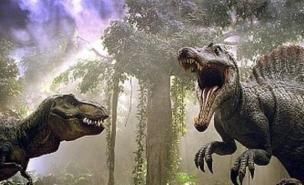
Archaeologists have unearthed a single 45cm-long fossilised browhorn belonging to a group of herbivores that included the famous Triceratops, at a geological site in the south-east of Montana, US.
While this is, in itself, not an unusual find, it is the placement of the fossil in the rock that is most important.
The fossil was found just 13cm below the layer of rock known as the Cretaceous-Tertiary - the point in rock formation that marks the extinction of the dinosaurs.
Scientists now believe this offers proof that dinosaurs were alive right up until the point where they suddenly disappeared - adding weight to the theory that they were suddenly and abruptly killed off.
Importantly, this find bridges the three-million-year time gap between the death of the dinosaurs and the impact of a giant meteor, which hit the Earth near Mexico around 65million years ago.
'This discovery provides some evidence that dinosaurs didn't slowly die out before the meteor struck,' Dr Tyler Lyson of Yale University explained.
'The fact that this specimen was so close to the boundary indicates that at least some dinosaurs were doing fine right up until the impact.'
Scientists have previously identified more than 1,000 species of non-avian dinosaur - however, including birds this number jumps to more than 8,000.



Where in the Milky Way Galaxy was our Solar System during it's orbit 65 million years ago?
Sometimes I wonder if these Asteroids actually came from Earth, perhaps from a Huge Volcanic Explosion that sent huge rocks or mountains up into the Atmosphere that fell back to the ground in numerous arrays.